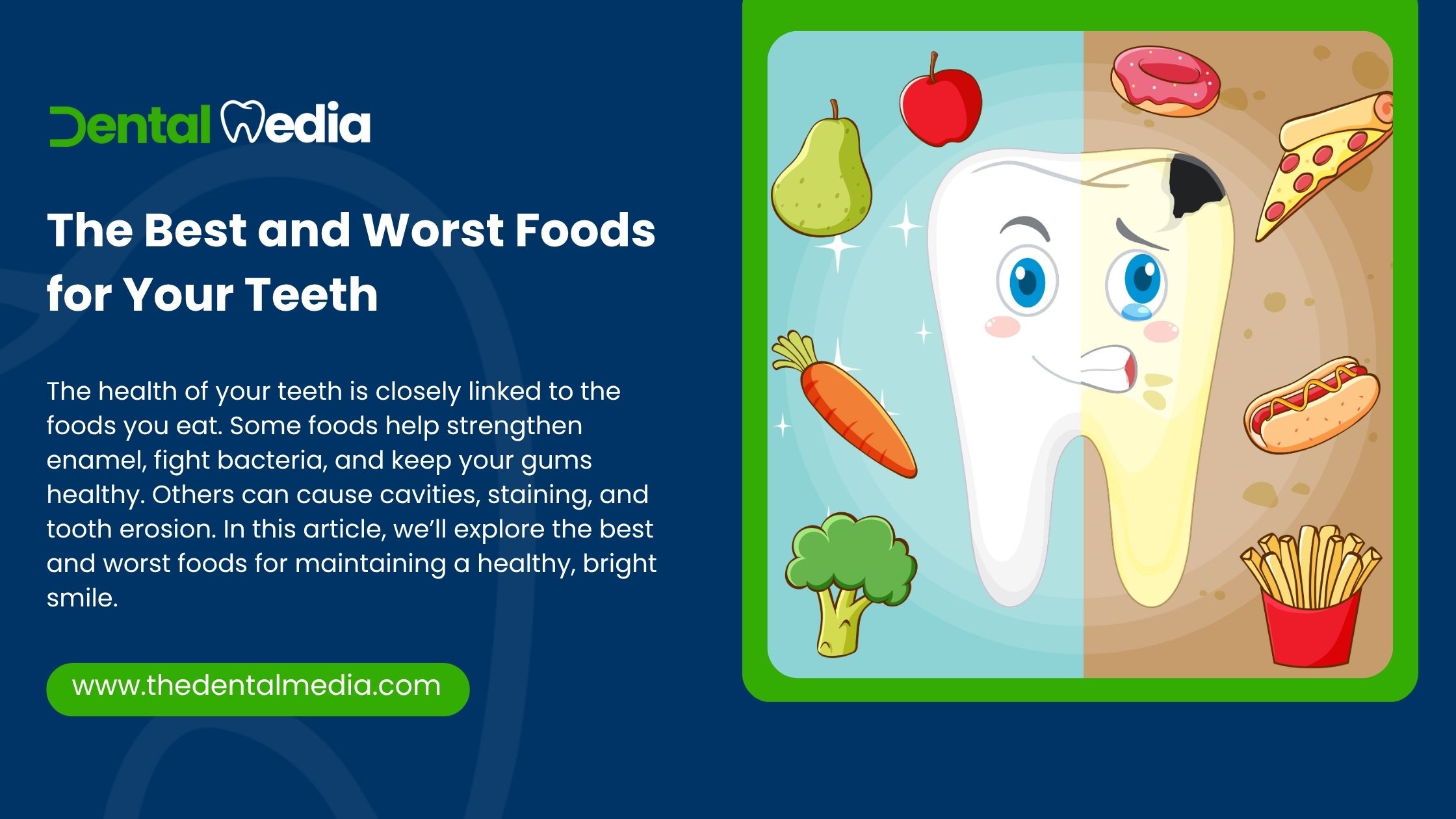Maintaining healthy teeth and gums isn’t just about brushing and flossing—it also heavily depends on what you eat and drink. Your diet plays a pivotal role in preventing cavities, gum disease, enamel erosion, and even bad breath. Some foods can strengthen your teeth and gums, while others can do significant damage over time.
In this article, we’ll explore:
- The best foods that promote oral health
- The worst foods that can damage your teeth
- Practical tips to protect your teeth through better nutrition
Best Foods for Your Teeth
1. Dairy Products: Milk, Cheese, and Yogurt
Why they’re good:
- Rich in calcium and phosphates, which help rebuild tooth enamel.
- Cheese stimulates saliva production, which neutralizes acids in the mouth.
- Yogurt contains probiotics that support healthy gums and fight harmful bacteria.
Pro Tip: Choose unsweetened yogurt to avoid added sugars that could harm your teeth.
2. Crunchy Fruits and Vegetables
Best choices: Apples, carrots, celery, cucumbers
Why they’re good:
- Their high water content dilutes sugars and increases saliva flow.
- The crunchy texture cleans teeth surfaces and stimulates gums.
- Rich in fiber and vitamins, especially Vitamin C, which is essential for gum health.
3. Leafy Greens and Vegetables
Best choices: Kale, spinach, broccoli
Why they’re good:
- Packed with calcium, folic acid, and vitamins that support enamel strength.
- Promote saliva production and provide minerals that remineralize enamel.
4. Nuts and Seeds
Why they’re good:
- Contain healthy fats, calcium, and phosphorus that protect teeth.
- Help in mechanical cleaning of the teeth while chewing.
Notable options: Almonds (low in sugar and high in calcium), sesame seeds (can scrub plaque while providing minerals)
5. Green and Black Tea
Why it’s good:
- Contains polyphenols that suppress harmful bacteria.
- Helps reduce plaque formation and cavities.
- Fluoride in tea (especially when brewed with fluoridated water) strengthens enamel.
6. Water (Especially Fluoridated Water
Why it’s good:
- Rinses away food particles and acids after meals.
- Helps maintain a neutral pH in the mouth.
- Fluoride strengthens tooth enamel and helps prevent decay.
Worst Foods for Your Teeth
1. Sugary Sweets and Candies
Examples: Lollipops, hard candies, gummies, caramels
Why they’re bad:
- High in sugar, which feeds harmful oral bacteria.
- Stick to teeth, promoting plaque and cavity formation.
- Sour candies are even worse due to added acidity, which erodes enamel.
2. Soft Drinks and Sodas
Why they’re bad:
- Packed with sugar and acid—a double threat to enamel.
- Regular consumption leads to demineralization of the teeth.
- Even diet sodas can be acidic due to carbonic and citric acids.
Pro Tip: If you do consume soda, drink it with a meal and rinse with water after.
3. Citrus Fruits and Juices
Examples: Lemons, oranges, grapefruits
Why they’re problematic:
- Contain natural acids that wear down enamel.
- Can cause tooth sensitivity and increase risk of decay with frequent exposure.
Best consumed in moderation, preferably with water and not between meals.
4. Starchy and Refined Carbohydrates
Examples: White bread, chips, crackers
Why they’re bad:
- Break down into simple sugars in the mouth.
- Often stick to teeth and feed bacteria that produce acid.
5. Alcohol
Why it’s harmful:
- Causes dry mouth, reducing saliva production.
- Saliva is essential for neutralizing acids and washing away food particles.
- Some alcoholic drinks (especially cocktails) are high in sugar and acids.
Tips to Protect Your Teeth Through Diet
- Rinse with water after consuming acidic or sugary foods.
- Chew sugar-free gum with xylitol to stimulate saliva and neutralize acids.
- Limit snacking between meals to give your saliva time to remineralize enamel.
- Use a straw when drinking sugary or acidic beverages to reduce contact with teeth.
- Wait 30 minutes before brushing after eating acidic foods to prevent enamel damage.
For more help and support, feel free to contact us at TheDentalMedia.com.

